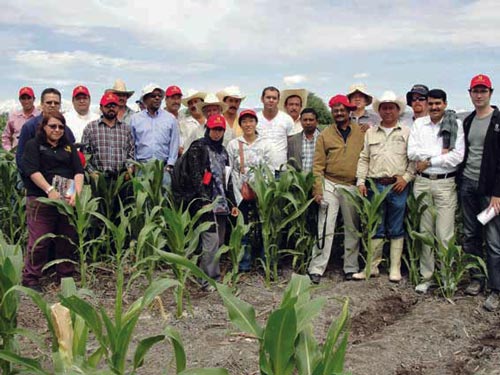 “It is very difficult to find conservation agriculture machinery. You have to go to China or India to get it,” said Mahesh Kumar Gathala, new CIMMYTBangladesh-based cropping systems agronomist for South Asia. Gathala, a native of India, was just one of the 15 participants invited to attend a five-week conservation agriculture course at CIMMYT-El Batán, Mexico, where improving machinery and professional capacity were hot topics.
“It is very difficult to find conservation agriculture machinery. You have to go to China or India to get it,” said Mahesh Kumar Gathala, new CIMMYTBangladesh-based cropping systems agronomist for South Asia. Gathala, a native of India, was just one of the 15 participants invited to attend a five-week conservation agriculture course at CIMMYT-El Batán, Mexico, where improving machinery and professional capacity were hot topics.
Begun in late May 2011, the course combined research advances in multidisciplinary approaches to sustainable crop management with the vast experience of countries in Asia, Africa, and Latin America. The main aim was to enhance participants’ understanding of the use and application of conservation agriculture sowing technologies and relevant agricultural implements in irrigated and rainfed wheat and maize production systems.
The participants came from Bangladesh, Pakistan, Afghanistan, Morocco, Tunisia, India, and Turkey. For many, it was their first time in Mexico. They spent most of their time at CIMMYT-El Batán, but also visited the Toluca station and farmers’ fields in Hidalgo to see CA practices in action and share experiences from their own countries.
Gathala noted the major differences in CA farming in Mexico and South Asia. “Fields are much smaller in Bangladesh, and crop residues are in much higher demand as animal feed,” he said. “These conditions make CA more difficult to push.” A CA practitioner for a decade, Gathala nonetheless felt the course was useful: “There is always something new to learn and share.”
Participant Raju Teggelli of India agreed. “I enjoyed the coursework, especially the practical experience. I found the instrument calibration and the hands-on training most useful,” said the Entomologist from the University of Agricultural Sciences, Raichur, in Karnataka, India.
Sincere thanks to all who made the course possible, and especially to the participants for their valuable and engaging contributions.